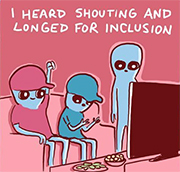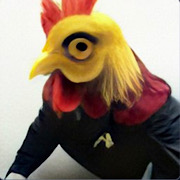|
Any hot tips on introducing a cat to my aussie? I have them separated with a baby gate and they pretty much just lay on separate sides of it and look at each other. I've been giving the doggo meat snacks when she sits there calmly and when I'm petting it so she is connecting the cat with treats. I've let the cat roam around the living room as well while I have the dog in a harness and leash while sitting and rewarding with treats when shes calm, and other then a "lunge" towards the cat when it started to climb the couch she did fine, which I think was mostly just reacting to a fast kitten climbing up stuff. Or i'd have the cat in my lap while the dog sits or lays calmly next to me while I pet the cat and rewards as well. Is it just pretty much keep doing that for awhile, or is there some other stuff I should be doing as well? The cat is about 3 months and the Aussie is 9 months.
|
|
|
|

|
| # ? Jun 8, 2024 16:14 |
|
That all sounds great. I'd be giving the cat plenty of vertical spaces to climb to get out of the dog's area, as well. It sounds like you're on the right track. Consistency is going to be important.
|
|
|
|
Ahh thank you. Today both the cat and dog were laying on the bed side by side with me (with lots of treats) so I think its going well. Efforts to contain the cat behind a baby gate are of no use as it just jumps over it even if the dog is on the other side. So far today she hasnt "chased" the cat but I think it helps that they have both smelled each other a bunch so far, and I think the cat gave the dog a boop on the nose when it got too close.
|
|
|
|
 "just sit still for mommy and don't touch the fire please" I never even had any idea of how amazing daily and small ongoing training sessions are. Sherlock and I train 3x/day for five minutes or more and our lives have changed. More work to do for sure but such a difference that just a year makes. Last year a shot like this wouldn't have even been possible!
|
|
|
|
You trained your dog to be Jewish?
|
|
|
|
Warbird posted:You trained your dog to be Jewish? yes and he is doing such a good job of it, right?!
|
|
|
|
Debatable, I don't know if it's kosher to eat 7 of the candles.
|
|
|
|
it was the first night 
|
|
|
|
My dog loves learning new tricks, but I'm not all that good at figuring how to break down the elements. Now I want to teach him something that would be actually helpful.* There are people in my house who keep leaving the burners on when they use the stove. I would like to train this dog to come and get somebody, or at least bark at the stove, when this happens. Obviously we don't want him to bark every time someone turns a burner on, though. I know dogs can be taught to alert their owners for a lot of things, but I don't know about this. Any thoughts? It's an electric range if that has any bearing on anything. *Actually he knows another helpful thing. I taught him to turn the basement light on, when our upstairs switch quit working. It was easier than fixing the switch...
|
|
|
|
I adopted a dog around 2 years old and she's really cool and smart. They said she was a beagle but she's obviously not a pure beagle, I think she's a beagle/coonhound mix. She came housetrained, crate trained and clicker trained and picks up new things very quickly. She also has a five foot vertical leap, thinks nothing of gates or fences that she can clear, and she is clearly well versed in the art of waiting for just the right moment when no one is looking scale the kitchen counter and help herself to whatever's up there. She can't be allowed to leave the room by herself, or be left loose when you leave the room, or she'll get into every trash can, knock glasses/mugs off of tables, and so on the moment she is sure nobody can see her. It's probably why she ended up at the shelter and I need to nip this poo poo in the bud. I've always had pure beagles so I know how to secure a trash can but at least they tend to get fat and stick to the ground. This is what happens I guess when you breed a hound to chase critters UP a thing. How to fix dog? I'd prefer not to have to crate her constantly, and to be able to go to the bathroom or whatever without waking up the dog and bringing her with me, and also to be able to have food on the counter in my kitchen ffs
poverty goat fucked around with this message at 00:04 on Jan 15, 2017 |
|
|
|
Belle D. Beagle has gotten into trash cans in the past, so we just moved them inside a nearby closet or laundry room so the temptation wasn't there. Short of that, I'd imagine doubling down on "leave it" world work if enforced whenever the pooch got near the trash.
|
|
|
|
Am I going along the right lines trying to teach our puppy 'in your bed' The issue I have is I generally want our pup to go in the bed when I want him to sleep, so I don't really want to praise him and wake him back up. As he is a puppy, we've also been toilet training, so we've kind of combined the 2 by saying 'wee wees' or 'poo poos' then praise, once he comes in we say in your bed and then he gets his treat. I guess I am just going to have to do some 'in your bed' training now he seems to be starting to understand it, independently from toilet time so he doesn't start to associate the wee/poo/in bed commands somehow Is there any other clever tricks?
|
|
|
|
We taught our dog "Go to Bed" by feeding her dinner in the crate. We just worked incrementally from putting her in her crate, saying "Go to bed" and then "Stay" and then going to get her food and delivering it to her in the crate. We started telling her "Go to bed" from further and further away from the crate as she figured out it was related to her getting dinner. Now I can say it anywhere in the house and she sprints for the crate. Sometimes she gets nothings, sometimes she gets a treat, at least once a day she gets her breakfast or lunch (if she doesn't go there on her own when I open the pantry). We did have a solid "Stay" in place before we attempted it, since the early part was getting her to not follow us to the pantry or run out when she heard us open the food bag.
|
|
|
|
So I got what's probably a weird question, and I don't know if it's normal or not, but we got a chihuahua mix puppy a while ago and she doesn't seem interested in playing tug. She nips and bites a lot, it's very excitable, and chews on everything EXCEPT the toys we buy her. She's not interested in those at all but she'll eat the hell out of a cord. I figured I'd start playing tug with her, but she doesn't care about it at all. I've tried introducing toys, then old socks even though it might be bad for her teeth, because I figured "hey maybe she'll play of its something of mine" but nope. She'll try to nip or hands instead, and if we keep at it she'll just get bored and walk off. I want to get her to play SOMETHING because she's so excitable and our other, older dogs can't really keep up, and tug seems easiest and I keep reading online like it should be natural, but she just doesn't give a poo poo. I dunno if this is the right place or if this had already been answered, if I hosed up I apologize 
|
|
|
|
Hi everyone! New dog owner! We just adopted a sheltie / pomeranian / something mix from a local rescue on Saturday. First vet appointment is next Thursday, but the rescue's vet put him at around 1 year. He's inquisitive, loving, and playful, and my wife and I are so stoked to have him. We both grew up with dogs, but it's been about 5 years since we've been living with one so we're loving it. I've been watching lots of YouTube training videos (really enjoying Kikopup's philosophy and the strong ethics & science behind what she's doing.) I have some background in behavior analysis, albeit directed at humans, so I'm familiar with the theory & practice but unfamiliar the specifics when it comes to dogs. I have a couple questions I'm hoping some of you nice folks could answer. 1. How long I should keep doing the same thing before reevaluating if I'm doing it right? I know he needs some repetition & reinforcement to be more likely to offer a behavior, but I often question and second-guess myself if I'm moving too quickly, or reinforcing the wrong behavior (or chain), etc. But then I remember that we haven't even had the pup an entire week, so I shouldn't expect any big behavioral changes after only a few training sessions. 2. Is it OK to shuffle what behaviors I target between training sessions, or should I stick to 1 and hit it consistently for a bit across several sessions? 3. He's great meeting dogs & people while on walks, or visiting neutral sites like dog parks or pet stores. However, when he's at home or in our yard he will bark, whine, and growl, put his paws up on the fence or door, etc when the dogs next door are outside. He'll usually alert less intensely when there are dogs and/or people farther out. I figured the drill with this would be getting his attention when he's barking at them, and clicking & treating for coming to and staying with me w/o barking or looking out the door, then slowly moving closer & closer to the door, then maybe having the door open, then moving to the yard, etc. I want to be careful because I don't want to reinforce barking like a maddog. Could I record a few training sessions and post 'em here for feedback? Or is there another online community that might do something like that?
|
|
|
|
Pit of Despair posted:So I got what's probably a weird question, and I don't know if it's normal or not, but we got a chihuahua mix puppy a while ago and she doesn't seem interested in playing tug. She nips and bites a lot, it's very excitable, and chews on everything EXCEPT the toys we buy her. She's not interested in those at all but she'll eat the hell out of a cord. I'm only a week into having my new puppy (he is a bit over 8 weeks now) but he wasn't interested in chewing on the rights things consistently for a few days. Would ignore rope toys and chew his bed, etc. I confine him to his playpen (a good size)/crate throughout the day and ensure that the only other objects accesible to him for chewing are his chew toys (and maybe metal water bowl but he doesn't chew that). I reward chewing on those toys with praise and ignore when he chews his bedding. I will sometimes let him chew on my hand to ensure he is regulating his bite strength with people, but I redirect him to chew toys tirelessly whenever possible until he starts chewing them. Having a good mix of toys may help - do you have puppy nylabones? I've been really impressed with his behavior improvements in just a few days using the playpen and crate system and always ignoring bad behaviors like whining for attention. He hasn't cried at night in two days and rarely whines when I leave the room. He goes outside exclusively unless I screw up and leave him out of my sight too long uncrated and after eating/playing hard.
|
|
|
|
Pit of Despair posted:So I got what's probably a weird question, and I don't know if it's normal or not, but we got a chihuahua mix puppy a while ago and she doesn't seem interested in playing tug. She nips and bites a lot, it's very excitable, and chews on everything EXCEPT the toys we buy her. She's not interested in those at all but she'll eat the hell out of a cord. Sometimes you just have to experiment and think outside of the box for what they find fun. Different sounds, textures, shapes, puzzle toys with treats in them, etc. Things that tap into prey drive might work better, like lunge whips/flirt poles (like large cat toys), seeing as she likes to go after your moving parts. As far as clicker training and new behaviors, i'd keep going if the dog is making progress, or move to the next step/add criteria only once they're 100% on the previous step. Repetition definitely is key, then you want to proof the behavior, in another setting or position perhaps, before you're sure it's really there. i think you can work on multiple things at once, but remember a 5 minute or so training session max 10 minutes for new behaviors is sort of the limit of attention span for most dogs. So after ~5 minutes of work , end it on a positive note with a success and a treat then relax time for awhile.
|
|
|
|
Whoever has that very well trained collie, I've seen your videos making youtube rounds so I'm hoping you're getting stuff for that.
|
|
|
|
|
I'm looking for some advice for dealing with my 7 year old miniature schnauzer. I raised him from a puppy and he is very protective of me. I live now with my fiance and her 3 kids (for about 2 years), and my dog still acts very weird around the kids. If any of them come into the room, he immediately gets up growling/whining and rushes over to investigate. It seems much more like anxiety behavior than aggressive, but it's concerning to have a growling/whining dog running rushing the kids every time they try to enter the room. I'm not afraid he'll bite them but it's definitely unwanted behavior. I've tried positive reinforcement (treats when they enter), and negative reinforcement (squirt bottle) but neither seems to really calm his anxiety or change his behavior. Any advice?
|
|
|
|
weas posted:I've tried positive reinforcement (treats when they enter), and negative reinforcement (squirt bottle) but neither seems to really calm his anxiety or change his behavior. Any advice? Where are the treats coming from? I would definitely quit punishing anxious behavior, since that is counterproductive. My best advice would be for the kids to be the one to drop a treat, if they're old enough. Keep a treat jar in the most trafficked room of the house, and ask the kids to pull one out and drop it for the dog if they come into the room and he's there.
|
|
|
|
Engineer Lenk posted:My best advice would be for the kids to be the one to drop a treat, if they're old enough. Keep a treat jar in the most trafficked room of the house, and ask the kids to pull one out and drop it for the dog if they come into the room and he's there. Thanks for the advice! Maybe the kids giving the treat is the missing element, we'll try that.
|
|
|
|
weas posted:Thanks for the advice! Maybe the kids giving the treat is the missing element, we'll try that. I would also stress to the kids to have very neutral body language and not to make eye contact (most important imo). Humans are kinda hard wired to look things in the eye and that's freaky as poo poo for dogs. What I did with my anxious dog when I first adopted him was have people who came into our bedroom throw strips of turkey lunch meat on the ground near him. We carried on conversation as normal with them continuing to throw pieces and not acknowledge him. It improved his nerves a lot, so I definitely agree with the advice given. I'd also like to add that make whatever treat you have the kids throw, make sure it's high value for your dog. If you don't mind perishables, the above mentioned lunch meat works well. If it's something that's just gonna be kept in a jar by the door, I'm a fan of meat based treats from Milo's Kitchen.
|
|
|
|
Not really sure if this is the right place, but my parents are having a really hard time with their three year old border collie, Lindy. It seems she's started to show signs of aggression towards other dogs. I think this is a bit strange because she was well socialised, and 3 seems a bit late for a dog to show aggressive adolescence behaviour. Borders aren't even a really aggressive breed, as far as I'm aware. Most strange is that, apparently, it's only towards dogs that are golden. She doesn't react well to golden labs, for example, but has never shown negative behaviour towards chocolate labs. I only occasionally walk Lindy when my parents are busy, but I so happened to today and saw the behaviour myself for the first time. Another owner with a goldy waved to us, and she seemed to know Lindy. So I went on over with Lindy, and Lindy greeted the other dog nicely. They played a bit, but I didn't let Lindy off leash (the other dog was free). They mostly proceeded to smell each other and wag their tails a lot, and Lindy looked very happy and wasn't displaying any behaviour that would seem to indicate that she was anything less than enthused to see this dog. And then she just suddenly moved to nip this other dog. She went from happy to vicious with absolutely no warning whatsoever. I pulled Lindy back immediately and walked in the other direction and Lindy went back to normal. She didn't want to go back to that other dog, nor did she seem perturbed in the slightest about what had happened. Now I'm not an expect on aggressive breeds. Maybe that's how it is when dogs get into dog fights. My parents are asking me for advice on the matter, but I've little experience with aggression. I guess what I want to know is, does this sound like normal aggression, or does it sound like there's some other issue here? As an extension, I see there are a number of books for aggression on the first page, but I'm not sure where to start with Lindy. She is very smart, even for a border, but also very flighty and emotional. She doesn't particularly like to share, and I've seen her get quite upset in the past when another dog took her ball, but it was never at a level where I felt I needed to intervene or Lindy might attack. I am just trying to think of where this behaviour could be coming from and I'm not making much sense of it.
|
|
|
|
ruta posted:Not really sure if this is the right place, but my parents are having a really hard time with their three year old border collie, Lindy. It seems she's started to show signs of aggression towards other dogs. I think this is a bit strange because she was well socialised, and 3 seems a bit late for a dog to show aggressive adolescence behaviour. Borders aren't even a really aggressive breed, as far as I'm aware. Most strange is that, apparently, it's only towards dogs that are golden. She doesn't react well to golden labs, for example, but has never shown negative behaviour towards chocolate labs. The way you describe this it doesn't sound like aggression, just that she got sick of an offleash dog in her face and acted so that they'd leave her alone (since you characterize it as a nip and she broke off readily). She may have given subtle body language cues as well - stiff wag rather than loose, freezing in the 'play', or a bit of whale eye. A lot of dogs lose their patience for extended social interaction around 3. Don't force it, and use a 5-second rule for greeting other dogs: let her interact for 5 seconds max, then call away. You can also ease the tension of that social situation by continuing to walk - everyone walking together usually means less face to face and fewer chances for an encounter to go south.
|
|
|
|
ruta posted:Not really sure if this is the right place, but my parents are having a really hard time with their three year old border collie, Lindy. It seems she's started to show signs of aggression towards other dogs. I think this is a bit strange because she was well socialised, and 3 seems a bit late for a dog to show aggressive adolescence behaviour. Borders aren't even a really aggressive breed, as far as I'm aware. Most strange is that, apparently, it's only towards dogs that are golden. She doesn't react well to golden labs, for example, but has never shown negative behaviour towards chocolate labs. Dog is definitely not aggressive or she would have started with lunging and landing an actual bite, not one snap (a snap doesn't contact the other dog, it's just a warning). Seems like she has a case of slightly reactive/slightly dog intolerant. It's totally possible for her to have had one bad interaction with a golden retriever and in her mind associated all dogs that look similar. Maybe one stole her ball one day? I don't know. She just probably has a limit on how long and how she wants social interaction. It always adds more tension when dogs greet on leash. If these two dogs were to meet in a park offleash, they may be fine as she could just walk away when she was done. I'd stop on leash socializing first of all. You don't have to say hi to other dogs on walks. If she has always gone to the dark park or socialized with certain dog friends offleash and been fine I don't see a reason to stop that activity. Meeting a dog face to face on leash is very provocative for dogs. If they met offleash they'd not sniff faces first.
|
|
|
|
Thanks all for the advice. It's reassuring to hear this isn't really aggression, and that maybe we're just getting on Lindy's nerves. I told my dad, who primarily walks Lindy, and he initially dismissed me, but he told me tonight that he was basically following my advice anyway. He says he only sees dogs if Lindy wants to and limits all interactions to 5 seconds. So far so good, or as good as I can hope to convince my stubborn old father anyway. I'll report back if issues continue to arise.
|
|
|
|
I taught my dog to sit and shake hands. I might have done something wrong because now when he's hungry he sits down and waves his paw in the air. It's the funniest thing.
|
|
|
|
that's not wrong - it's really good. He's offering you good behaviours in an attempt to get a reward. That is exactly what you want in dog training. It's much better than my demonic boston terrier doing naughty things to try to get a reward - believe me!
|
|
|
|
Useless trick: https://www.youtube.com/watch?v=PUKgx8iMK2o
|
|
|
|
Heyyyyyyy long time since I posted in the formally PI forum my dog is a big butt towards other days. Hates 'em. I think this is a combination of her always not being able to handle a ton of dog interaction (got overwhelmed with lots of dogs around here when she was younger, seemed like she hated a bunch of dogs crowding up to her, etc), an escalating leash reactivity we didn't catch in time (I kind of think this went back to when a neighbor in an old apartment we lived in got a dog and our dog heard them going in and out all the time and slowly conditioned herself to get worked up when she heard collar jingling and that transferred over to seeing dogs and again that jingle is a big trigger), and at some point she got Lyme disease (tested positive for it) and while she never showed a lot of visible signs (didn't limp around or look like she was in pain), thinking back this was around the time she started getting a lot more defensive of her personal space with both people and other dogs and I can think of some times she seemed sensitive go being touched in certain ways. She also used to be at least OK off leash (doesn't really want to play with dogs and would sometimes race over and be a butt in a herding dog chase that other dog way and then leave them) but we had an incident where she got into a fight with another dog and did a little damage...but the situation was a weird one and we were in the middle of moving so she was under a lot of stress and it may have been more of a "you're on my turf" thing and we didn't see the actual start of the issue. But at this point we're certainly wary about letting her around other dogs even off leash. SO, that all said, we've generally tried a lot of redirection and trying to change her responses through conditioning but it hasn't worked great. Maybe we're not being consistent enough but part of the problem seems to be that she gets sooooo worked up so fast that it's tough to bring that back down to a better level. She can still take direction and treats while worked up to a certain point but it definitely makes things a lot harder because she's so amped up and I think there's some amount of being too worked up to back herself down easily I guess I'm asking how people would start working with a situation like that where the reaction is intense and explosive without a lot of ramp up that allows for de-escalation, and poo poo maybe a review of how you'd work with conditioning or other methods to try to get across the idea of "it's better to be cool when you see other dogs". I'm also in the Bay Area now so if anyone knows any good trainers (preferably in the city or north bay) I'd be interested...
|
|
|
|
Levitate posted:Heyyyyyyy long time since I posted in the formally PI forum This site is good: http://careforreactivedogs.com/ The best thing is to keep the dog under threshold (not reacting) because that cortisol will stay in the system after a big release of adrenaline. You may have a case where the dogs threshold is really easy to reach, or their 'bubble' is huge and very easy to pierce if you think of it that way. If that takes doing your walks at midnight or before dawn for awhile, or driving to an abandoned field to walk instead of around your house, that is what is going to help the most. You want to mostly avoid other dogs. Now you won't teach her that Dogs = good things! if you never see another dog, but it's evident that she's often too far over threshold, and the learning process doesn't take place very efficiently when the dog is over threshold. Perhaps there's just too many dogs in your neighborhood or they're too close to her. What you're looking for, is she sees a dog in the distance, or hears dog tags jingle, you say her name or just wave really stinky yummy treats at her and she eats them. If she's not eating them or already overreacting, she's over threshold and not really learning to associate them positively. The goal is that she sees or hears a trigger and she looks to you for reinforcement (really good treats). You have to create this association and it will take some patience. But eventually the bubble should get smaller, and eventually you can maybe pass dogs on opposite sides of the street and she is not freaking out and taking treats, ideally, and you move on with your day and her stress levels didn't rise significantly so she holds it together. So you said you've worked on this, but the key in this case, it can be nuanced, is making sure you're actually pairing the reinforcement with the trigger, which takes some skill in reading your dog's body language and skill in timing. you don't want to be 'bribing' or luring with treats before you see a dog. the treats will suddenly appear AFTER _she_ notices the trigger. And of course keeping the dog under threshold, where learning the positive associations best takes place. Trigger stacking is another foe. An in person trainer may be able to help you with this more in depth. Here's one behaviorist I found maybe near enough to you: http://www.vetbehaviorspecialists.com/index.html And you can look on this site: http://www.ccpdt.org/dog-owners/certified-dog-trainer-directory/ for trainers near you.
|
|
|
|
Separation anxiety question for you all. Our beagle has a pretty bad case of SA, but we have gotten her familiar enough with her crate via crate games that she will (usually) go in it if bid and will stay pretty quiet if we leave while she's in there. We still have minor accidents due to "I got scared and peed a bit", but she's improving. However, she will utterly ignore any food/treats/toys in her crate while she is locked in there or we are gone. I'm glad she isn't making a mess or racket, but I'm not sure if her sitting/lying in her crate comatose in terror is good for her or not. Thoughts?
|
|
|
|
I'd say if she's afraid then it's not good. We have followed Patricia McConnell's instructions in I'll Be Home Soon for two separation anxiety dogs and it's been a great help. I highly recommend it. It takes a while but it does eventually work. The main thing is to not leave your dog alone until they are not afraid of it any more... every time they are scared and the bad thing happens (you leave) then you are just reinforcing the fear. Set up a system of dog sitters and doggy day care so your dog feels safe. When we first got her, our very anxious dog wouldn't eat any time she thought we might be leaving but now she will eat and be calm by herself for over an hour. It's a HUGE accomplishment for her. It seems daunting but definitely try the training.
|
|
|
|
I bought and read it a bit back, but got side tracked by other things before I could start implementing it. I don't mind doing so again, but a bulleted/order list of "Do X, then Y until Z" would be amazing. The trainer I used to work with before had something similar for separation games and it was a big help. Thankfully someone is almost always home, so we're keeping the reinforcement to a minimum I hope. I've been mulling over obedience training, so we might get someone to assist. The pooch is damned good at tricks, but I've been unable to "polish" the more basic stuff so far. Most people just say "Them's beagles for you", but I don't know if I believe it. Edit - I'm going to reread it, but can I assume this will do in the meantime? Edit edit - Hot takes on medication would be appreciated too. The wife and I aren't too enthusiastic on the notion, but using it with the understanding of it being a temporary measure to get her "reset to 0" during SA training is something I can live with. Warbird fucked around with this message at 14:30 on Mar 22, 2017 |
|
|
|
My girlfriend brought a cat home a few weeks ago, and ever since then our previously house trained dog has started pissing in the bathroom (and raids the litter tray) while we sleep. She doesn't have any accidents during the day, and spent a weekend at my parents while we were in Amsterdam with no issues at all, so I'm guessing it's a stress response to the changes in the house. How can I correct for behavior I'm not awake to see? Abiggoat fucked around with this message at 23:41 on Mar 22, 2017 |
|
|
|
Abiggoat posted:My girlfriend brought a cat home a few weeks ago, and ever since then our previously house trained dog has started pissing in the bathroom (and raids the litter tray) while we sleep. Or it's the fact that the cat pees in the house, so now it smells like urine. Remove access to the bathroom for the dog and get a top entry litter box if your cat has decent mobility. I would probably crate the dog at night.
|
|
|
|
Warbird posted:Edit - I'm going to reread it, but can I assume this will do in the meantime? Yes, that's great. Warbird posted:Edit edit - Hot takes on medication would be appreciated too. The wife and I aren't too enthusiastic on the notion, but using it with the understanding of it being a temporary measure to get her "reset to 0" during SA training is something I can live with. Noodle was on Xanax and Prozac when we got her from the shelter but she still panicked so we weaned her off them. The Prozac in particular reduced her appetite so much that it interfered with the training. I heard that it can help but not in Noodle's case. If you are open to trying it, our other SA dog was ok as long as she had another dog around. You could borrow one and see. Edit: also we don't use a crate for Noodle since we are sure she had bad experiences with one. We keep her confined to a few rooms and away from the cats so she won't have to guard her food. She mostly looks out the window while we are gone though, so we haven't had any trash eating to deal with. Joburg fucked around with this message at 05:56 on Mar 23, 2017 |
|
|
|
Trazodone has been the most helpful one for my dog with separation anxiety and sound phobias. That along with taking her for a walk/run around the park before leaving for work. Waking up at dawn sucks but sucks more to see her in anguish.
|
|
|
|
We recently (4 months ago) adopted 2 kittens into the house and our dog has been mostly tolerating them. She would lick them, occasionally play but would growl at them if they ever entered her personal space. Lately though, she has developed food guarding tendencies to the point where she is now growling and barking at my wife. It took her 45 minutes to eat today. We have been taking her for a walk around the block before every meal, have her sit/stay while we pour the food and releasing her to eat it. We then reward her for eating her food and continuously drop treats in while she's eating to make her feel more comfortable around us. We have also taken to sitting next to her while she eats to give her the sense of calm and "we mean you no harm". Every day we seem to get closer to her just eating when we put the bowl down, she will revert to the 45 minute guarding/barking thing again. I suspect it's the dogs perception of my wife in tandem with the kittens always floating around the place. I think my next step will be to set her crate back up and feed her in there but I know for a fact that the kittens will go in there immediately. They have no fear of the dog and are just being dicks like kittens do.
|
|
|
|

|
| # ? Jun 8, 2024 16:14 |
|
Sitting next to her could be working against you. Do you have a room where you could corral the kittens while the dog eats?
|
|
|
































